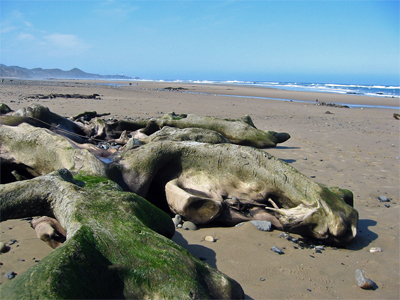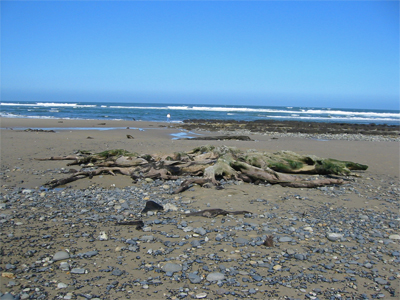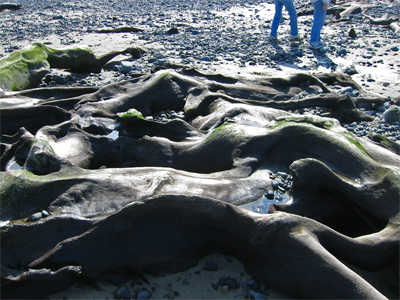A Forest Buried Alive
Newport, Oregon—Beach sands come and go. Along the central Oregon coast recently, unusually low tides scoured beaches down to their lowest sand levels in years, perhaps centuries. So much was removed that remains of ancient forests, buried alive by building sands thousands of years ago, once again saw the light of day.

Fossil tree root masses such as those exposed at Moolack Beach, Oregon, (above) tell tales of ancient seaside "ghost forests" that thrived here thousands of years ago.
In Connecticut, we’re accustomed to tides and wave action reshaping beaches and sand spits at places such as Bluff Point State Park’s Bushy Point, but the erosion and pace of change along Oregon’s central Coast has been several orders of magnitude greater.
During our summer vacation, we found the Marine Gardens beach at Otter Rock, Oregon, practically scraped bare, down to the marine sediments underlying it, rocks normally buried beneath several feet of medium-grain sand. Finding it in such a state, with its headlands significantly eroded in the past six months and ordinarily abundant tide pool fauna such as anemones forced further seaward, was distressing.
“It looks like some unusual erosion is going on--erosion that has not happened much in 4,000 years,” geologist Roger Hart of the Oregon Dept. of Geology and Mineral Industries and an expert on central coast tree remains told the Newport News-Times.

At many beaches here, from Moolack Beach (above) to neighboring Beverly Beach, to others further north, such as Neskowin Beach, recent erosion has exposed very large root masses and great tree trunks, particularly where creeks excavated even deeper. Low “minus tides” of –1.4 feet resulted in extraordinary views of these prehistoric fossil tree parts and tree bases, some as much as thirty or forty-feet across.
The roots, stumps, trunks and cones are between 4,100 years old (based on radiometric dating) and 2,500 years old (based on archaeological studies of Native American sites around Newport’s Yaquina Head). They are the remains of what were great seaside forests of Sitka Spruce trees, titans of the primordial Northwest rainforests and ancestors of Sitka Spruce that dominate coastal forests today.
Following the retreat of glacial ice, forest trees had spread over Oregon’s Coast Range Mountains and down to the Pacific coast. Roger Hart says that about 4,000 years ago, vast amounts of sand (which Yaquina Head reveals to have been piled hundreds of feet high) came to quickly penetrate the forests and bury them alive. Dunes grew to entomb trees so completely they were protected from decay by oxygen and bacteria and preserved for the millennia.
Hart and fellow researcher Curt Peterson have reported 14 fossil sites and 520 fossil stumps or root masses. They describe a three-part process of forest advance, sand burial and erosion/exposure. The cycle began long ago with the seaward advance of the forest; was followed by its burial and preservation by deep deposits of beach and/or dune sands; and brought full-cycle with the removal of the sand, and re-exposure of the forest, by wave action and the landward erosion of coastal headlands today.

It’s hard to imagine that geologic change can sometimes be so quick as to bury giant trees alive, but the pace at which surficial features along the Oregon coast have been eroded in the past six months reveals how such events can sometimes be as swift as they are catastrophic.
1 Comments:
I keep meaning to take pictures of the salt marsh erosion going on here in Guilford. I wonder how long it takes to pack and grind salt grass into about 5 feet of clay sediment... The coolest [or scariest] thing to see is that about nine feet down by the west river, there's a layer of sod that is similar to what we walk on now. That must mean that this sediment may have landed on top of the preserved layer en-mass at some point in the past. There are occasional sharpened sticks protruding out, as well. I wonder how old they are.
Post a Comment
<< Home